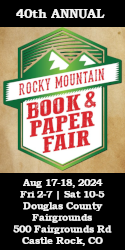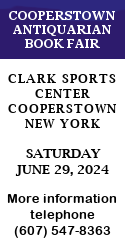The Last Bookshop & Statistics Show...
Just about anything you want them to – especially useful for people pushing social or public policy agendas. An inescapable element of any controversial public debate is the part when someone inevitably drops the “statistics show” or “studies show” argument, the hollowest of trump cards. As you might guess, there's a vast super-market of studies and statistics out there ready to be cherry-picked by anyone with an agenda to push and, not surprisingly, people with opposing viewpoints can usually find plenty with which to hit each other over the head.
And as far as the “studies” themselves go I'm also convinced that many are based on statistics carefully selected or weighted according to how they support the agenda of the study's sponsor.
This is my first column to appear on this website that has not been published previously in Book Source Magazine, the last of which was mailed on April 12th of this year (May/June 2013; vol. 29, no.4). After everything I've said over the years about my preferring to read words on paper, maybe I should have entitled this piece “Eating Crow” but there are good reasons to justify our pulling the plug on the print version that I'll attempt to explain here.
I have no statistics or studies to quote, just 28 years of accumulated anecdotal evidence which, as we all know, does not even remotely qualify as scientific information relating to what or how people read – or whether they even read at all. What I can report is how economic realities affect all of the above – at least as far as we're concerned.
Approximately 80-85% of the total revenue of the print version of Book Source Magazine went to pay for printing, mailing and shipping. And, interestingly, roughly the same percentage of readers were quite content to rely on free samples picked up at book fairs or cadged from booksellers who paid for their stock of BSM.
Since announcing the complete change from hard paper copy to internet publication we've received some very kind notes and calls from many of our long-time subscribers, but we've also read and listened to an even greater number of lamentations, ululations and complaints from “supporters” who have expressed disappointment and annoyance that they'll no longer be able to pick up free samples at book fairs and bookstores. One in particular, a retired professor from a nearby university who has relied on free samples since the 1980s, thought it was “terrible” that we would sell off some of the bits and pieces (which we have done) and shut down the print magazine.
At any rate, the deed is done and anyone on the planet has free access to this website which is now updated much more frequently – sometimes several times a day. Also, visitors to the Book Source Magazine website may be assured that we do absolutely no data mining at all. We don't know and don't care to know who visits our website. What government snoops and various search engines do is an entirely different matter. That, obviously, is beyond our control.
Other changes will certainly include more wide-ranging and free-wheeling content. Anthony Marshall will be contributing from either Freiburg (Germany) or Melbourne (Australia) and we're in the process of setting up an “Ephemera Bits” page for Diane De Blois. Controversial topics totally unrelated to the antiquarian book trade will not be avoided and we expect to offer a readers' page in due course. We're sort of reinventing ourselves as we go and can't wait to see what this website will be like in a year's time.
The Last Bookshop
Many of you know about or have seen the short film entitled The Last Bookshop which can be viewed on YouTube. A little more than 20 minutes long, it features two actors – an elderly bookseller and a young boy who discovers a bookshop from the past while aimlessly wandering the streets after his family's electronic media system breaks down. Filming was done at various bookshop locations, including Halls Bookshop in Tunbridge Wells (for the exterior shots) and at Baggins Books in Rochester (Kent). Many of the interior views, showing endless ranges of shelving stretching from floor to ceiling, were made at Baggins, one of the largest bookshops in England and one of two bookshops (the other being Piccadilly Rare Books in Ticehurst) that were owned by Paul Minet who contributed Letter from England to this magazine for many years.
Notes from the Garden
The ongoing flooding of certain parts of central New York, especially Madison and Chenango counties, while causing great damage to many homes, farms and roads in the more low-lying areas has not left higher elevations (where we live) entirely unscathed. Our main vegetable garden has remained partly submerged since late May and I don't think we've had more than two or three dry days in a row since the end of winter. Unless weather improves dramatically fairly soon I think we can call it a loss for this year. Still, when compared to what our neighbors in and around the city of Oneida have had to endure of late, I have no cause for complaint.
On the bright side, the day lilies (especially Stella de Oro, aka Stella d'Oro) and yucca have done spectacularly well – at least twice the blooms compared to years past. Most of our annual and perennial flower beds, while on the wet side, are located in more suitable well-drained areas and should make up for the disappointing loss of most of the vegetable gardens.
For newcomers to this website, occasional notes from the garden crept into the print magazine several years ago and has remained ever since. Don't remember how and why it started – probably influenced by Robin Lane Fox, an Oxford classicist and weekend gardening columnist for the Financial Times.
*
Dreadnought & Saying Goodbye (Published previously)
I've been reading Robert Massie's Dreadnought: Britain, Germany, and the Coming of the Great War (New York: Random House, 1991) for much of the winter – it's not because I'm a slow reader, but Massie's ability to breathe so much life into the history he knows so intimately makes the reader want to take plenty of time to absorb and reflect on what's been read. I wouldn't rush through one of Massie's books any more than I'd down a glass of the best oloroso or cortado Spanish sherry as if it were a pint of draft Yuengling. Nothing against Yuengling – it's probably my favorite non-pretentious go-to lager.
The parallel narratives, from both the English and German perspectives, relying heavily on letters, journals, contemporary accounts and earlier histories, focus on the late Victorian and Edwardian periods when ship design and construction methods were changing radically, naval tactics were undergoing a major rethinking, and all of it happening in a relatively short period of time.... (continued on the archive page)

























